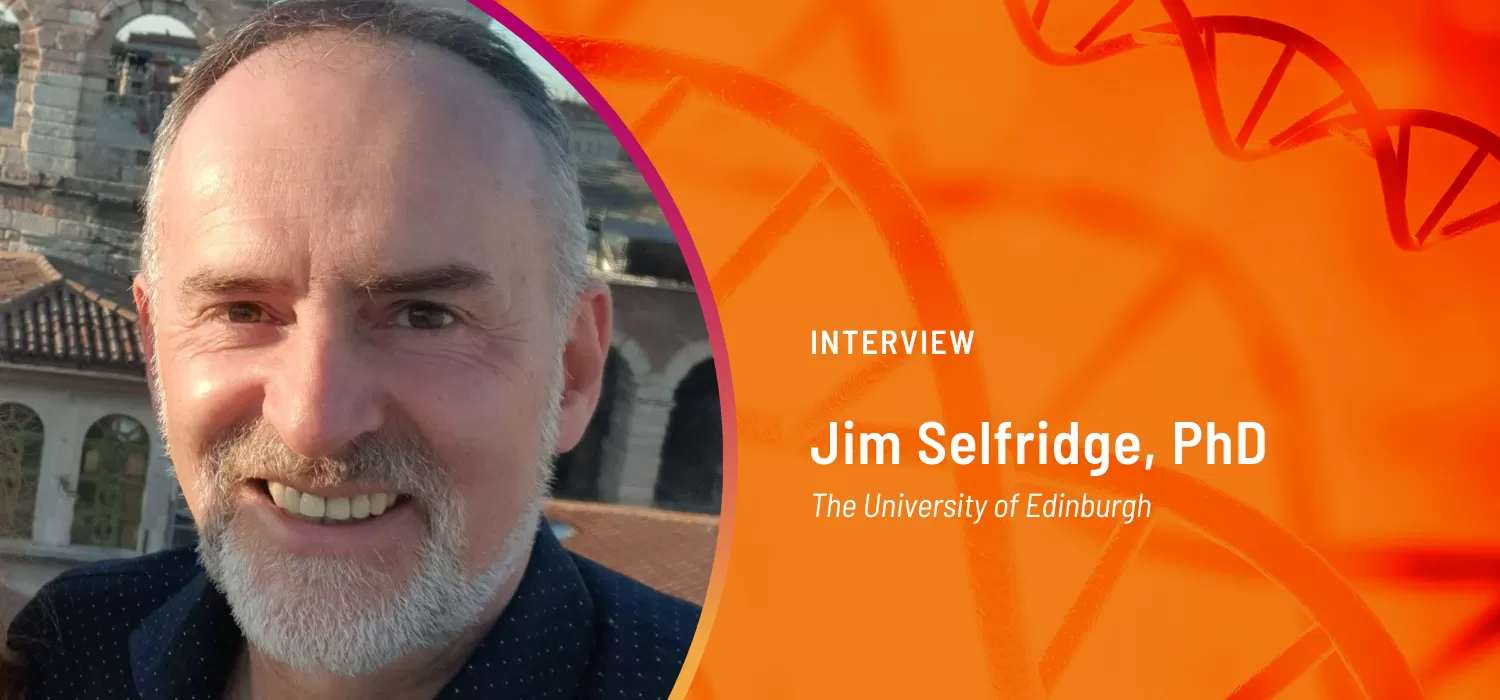"There are no 'crazy experiments' when it comes to Rett"

Jim Selfridge is a dedicated researcher at the University of Edinburgh whose work centers around Rett syndrome. With a passion for unraveling Rett's mysteries, he investigates the underlying genetic and molecular mechanisms involved, striving to develop targeted therapies. Having worked on Rett research for more than two decades, we asked Jim about his expertise and commitment to advancing our understanding of the disorder and paving the way for potential breakthrough treatments.
Tell us about your research on Rett syndrome.
My involvement with Rett was largely by chance in the first instance. Throughout my career I have been involved in making mouse models of human inherited disorders. My work with Rett began back in 2000 when I joined the lab of Adrian Bird, PhD, to help study the function of methyl-binding proteins, including the MECP2 protein. This was just after the MECP2 gene was identified as the gene responsible for Rett syndrome.
To be honest, I always thought we were just going to get a better understanding of why MECP2 mutations led to such a devastating disorder. I never dreamt we would begin a journey toward developing a therapy. But then Adrian and Jacky Guy, PhD, came up with an idea for a “crazy” experiment, the 2007 reversal experiment, and everything changed. Slowly I realized that our work could make a difference, and I wanted to be part of the effort.
In 2021 I joined Stuart Cobb’s lab where the focus was on developing therapeutic strategies for Rett. We believe if we can put a healthy version of the MECP2 gene back into neurons the brain should be able to function properly again. We have developed a delivery system whereby we will use a harmless virus, which acts like a mailman to take a working copy of the gene into the cells that need it.
I often use a car engine as an analogy: Think of a dirty spark plug as a faulty gene. If you have a dirty spark plug in your engine the car won’t run properly. Put in a replacement spark plug and your car should be good to go. It is called genetic engineering after all!
Can you share more about what you are working on right now in terms of Rett research?
Earlier this year this work led to Neurogene gaining FDA approval to begin a clinical trial in the US, which is a massive milestone and underlines the progress that we have all made. We will continue to consider ways in which existing approaches could be optimized, and I look forward to continuing working with RSRT in the pre-clinical development of therapeutic strategies. One thing I have learned from my research is that there are no “crazy experiments'' when it comes to Rett.
What about Rett syndrome presents interesting and motivating scientific challenges?
Challenging is a good word when considering Rett research! Despite working on MECP2 and Rett for over 20 years, we still don’t fully understand everything. To begin with we thought we only had to find the one or two genes that MECP2 regulated. But we couldn’t have been more wrong, it turns out MECP2 acts globally on a wide variety of different genes.
What is the ultimate goal of your work?
My work has been a classic bench-to-bedside journey, taking basic scientific research to the clinic. The ultimate goal, for me, would be that my work in some way contributes to somebody with Rett syndrome having a better life. My perspective is undoubtedly very different from that of a parent or carer, so I don’t know if that means no more seizures, being able to walk, being able to tell their parents how they’re feeling, being able to hold onto their favorite toy, being able to enjoy chocolate again, or simply not being anxious.
What gets you up every morning and excited to come to work?
As a research scientist you are constantly asking questions: what if, why is that …? This means we continue to learn new information that could potentially solve the problem! It’s hard to believe, and equally frustrating, that it’s taken 16 years from the reversal experiment to gaining approval for gene therapy trials to begin, but we have answered so many questions along the way and learned so much about Rett syndrome.
What do you like about working with the Rett Syndrome Research Trust?
Most people can name a handful of famous scientists, but the truth is research is the result of teamwork. RSRT recognized this and convinced many of these teams that they should and could work together rather than compete with each other. It was such a refreshing approach to scientific research, and Monica is the only person I can imagine making it happen. When you have an inspirational lead, the rest becomes a lot easier! It has given me the opportunity to work with some brilliant scientists.
What would you like to tell Rett parents and other members of the Rett syndrome community?
When I started working on Rett syndrome, nobody was talking about a cure, but we are now on the brink of starting gene therapy clinical trials. This is largely because RSRT has ensured that a lot of brilliant scientists have dedicated their time to addressing the challenges posed by Rett, and I believe we are about to reap the benefits.


